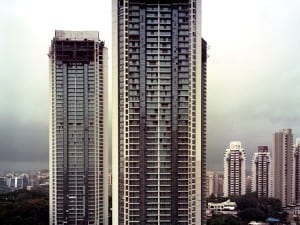Review by Isabella Andronos
A decadent feast appears in the space at Artereal Gallery; a table set with goblets and candlesticks among abundant seafood, fruit and wine. Rococo style pillars topped with urns spilling fruit, an enormous chandelier and five detailed frames also occupy the space. These are sculptural works made by Ken and Julia Yonetani, each comprised entirely of salt. The works explore a contemporary interpretation of a traditional theme in painting, the still life, taking this idea into the third dimension.
Salt is vital for all living creatures. It is essential, but salt can also be deadly. The work of Ken and Julia Yonetani has particular relevance to contemporary Australian issues, related to the highly saline groundwater along the Murray-Darling Basin. Supported by the Australian Network for Art and Technology, Sunrise 21, Murray-Darling Freshwater Research Centre and the Australia Council for the Arts the works emerged as part of a Synapse residency in Mildura. Salt from the Murray-Darling area was used to create the sculptural works. Enacted entirely of salt, the works herald a link to this site, challenging audiences to consider the destructive implications of salinisation and the possibility of environmental decline.
There are obvious visual ties to the decadent table spreads in traditional still life painting, particularly of the Vanitas genre. Showing painted depictions of indulgent spreads of food, wine, flowers and skulls, these works aimed to represent the brevity of human life and the problems associated with a hedonistic lifestyle. Understanding salt as a destructive element, as in the case of the Murray-Darling Basin, the works can be seen as a warning, as an ominous symbol for the possibility of the death of the ecosystem. Devoid of colour, the white of the salt acts as a stark distinction between the Yonetani’s work and the boldly coloured images of the traditional still life painting. Their work transcends the two-dimensional painted surface of traditional still life painting, drawing sculptural elements together to create an intimate representation of contemporary issues. By depicting a lavish table setting, the Yonetari’s make reference to the global issues related to food; food wastage, food shortage, and human destruction of the environment.
An enormous chandelier, comprised of 5 000 individually cast grapes, hangs close to the front window of the gallery. Each grape has a grainy textural surface, every single piece created using Murray-Darling salt. Suspended from the ceiling, the small cast shapes appear like crystals. At over two meters high, the sculpture becomes an enigmatic representation of bourgeois decadence. Also in the gallery space is The Five Senses, a series of five ornamental frames made of salt which are displayed on the walls of the gallery. There is no picture within the frame; the void space shows only the wall it is displayed on. The intricate pattern on the surface of the frames can be linked to the traditional gilded frames of the Renaissance period. The small grains of salt which comprise the structure glisten as they catch the light from the gallery. The title of the works comes from the series of paintings, The Five Senses, 1617-1618, by Jan Brueghel and Peter Paul Rubens, each which depicts one sense; taste, smell, vision, touch and hearing. These paintings, with all the decadence of the Renaissance aesthetic, depict elaborate scenes busy with objects, furniture, human figures, animals, paintings, food, musical instruments and both the interior and exterior landscape. Removed from the lively and chaotic traditional images, the Yonetani’s work appears quite minimal. Subverting the traditional use of the frame, seen as a means of hanging a painting, the frames created by the Yonetani’s act as aesthetic objects. They are paired back and stripped of their traditional context. They exist as objects in themselves, rather than acting simply as a structure to contain an image.
Salt aids in the formation of clouds, it was used for funeral offerings in ancient Egypt, it was traded for wine and commodities by the ancient Celts; it is essential for life but also dangerous in excess. The work of Ken and Julia Yonetani is enigmatic, salt structures have been created which symbolise the importance of balance within ecosystems. Using salt from the Murray-Darling Basin, the works create awareness about salinisation and problems with environmental decline in this area.
Still Life: The Food Bowl by Ken + Julia Yonetani continues until 2 July, 2011 at Artereal Gallery, Australia.
Still Life continues to Arts Mildura as part of Mildura Palimpsest #8: Collaborators and Saboteurs 9 – 11 Sept and
GV Art, London from 6 Oct – 22 Nov.
kenandjuliayonetani.com
artereal.com.au
Aesthetica Magazine
We hope you enjoying reading the Aesthetica Blog, if you want to explore more of the best in contemporary arts and culture you should read us in print too. In the spirit of celebration, Issue 41 includes a piece on Guggenheimn Bilbao where the Luminous Interval features internationally acclaimed artists such as Louise Bourgeois, Kiki Smith and Damien Hirst, ArtAngel’s new commission at MIF, Bruce Nauman’s retrospective at The Kunsthalle Mannheim and Cory Arcangel’s Pro Tools at the Whitney in NYC. You can buy it today by calling +44(0)1904 479 168. Even better, subscribe to Aesthetica and save 20%. Go on, enjoy!
Image:
Ken + Julia Yonetani
Still Life: The Food Bowl (installation shot)
2011
Murray River salt
Dimensions variable
Images courtesy of the Artists and Artereal Gallery, Sydney.





